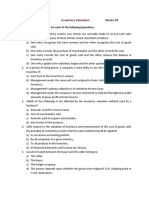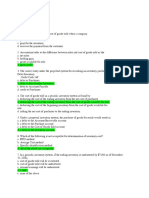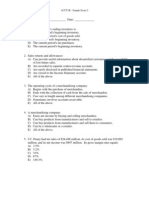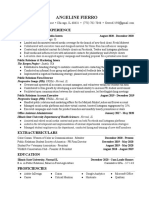Test Chapter 8 Principles Sample Test
Uploaded by
Jacob WagenknechtTest Chapter 8 Principles Sample Test
Uploaded by
Jacob WagenknechtChapter 8 Sample Test - Principles of Accounting 1
True/False Indicate whether the statement is true or false. ____ ____ 1. Days' inventory on hand equals the inventory turnover divided by 365. 2. An understatement of ending inventory in a period will result in an overstatement of gross margin in the next period. 3. Inventory turnover is a measure expressed in terms of a percentage. 4. Goods in transit shipped FOB shipping point should not be included in the seller's ending inventory. 5. Goods held on consignment should be included in the consignee's ending inventory. 6. Merchandise inventory is valued on the balance sheet at the expected resale price. 7. In periods of rising prices, the FIFO method will result in a larger gross margin than the LIFO method. 8. In periods of falling prices, LIFO will result in a higher ending inventory valuation than FIFO. 9. The FIFO inventory method does not produce the most up-to-date figure for ending inventory.
____ ____ ____ ____ ____ ____ ____
____ 10. The average-cost method produces an ending inventory figure that is somewhere between the figures produced by FIFO and LIFO. ____ 11. When the average-cost method is applied to a perpetual inventory system, the sale of goods will change the unit cost of the goods that remain in inventory. ____ 12. Both the retail method and the gross profit method are useful in estimating the inventory cost. ____ 13. A cost-to-retail percentage must be calculated when applying the retail method. Multiple Choice Identify the choice that best completes the statement or answers the question. ____ 14. Average inventory equals $100,000, and cost of goods sold equals $221,000. Days' inventory on hand equals a. 165.2 days. b. 165.2 days. c. 154.3 days. d. 188.7 days. ____ 15. An understatement of ending inventory in one period results in a. an overstatement of the ending inventory of the next period. b. an understatement of gross margin of the next period. c. an overstatement of gross margin of the next period. d. no effect on gross margin of the next period.
____ 16. An understatement of year 1's beginning inventory will a. cause year 2's gross margin to be overstated. b. cause year 1's cost of goods sold to be understated. c. cause year 2's gross margin to be understated. d. have no effect on year 1's gross margin. ____ 17. Which of the following is an inventory costing method? a. Perpetual b. Lower-of-cost-or-market c. Specific identification d. Periodic ____ 18. A fur dealer probably would use which of the following inventory methods? a. Specific identification b. FIFO c. Average-cost d. LIFO ____ 19. Use this inventory information for the month of June to answer the following question. June 1 5 14 21 30 Beginning inventory Purchase Sale Purchase Sale 10 units @ $120 60 units @ $112 40 units 30 units @ $116 28 units
Assuming that a periodic inventory system is used, what is cost of goods sold under the average-cost method? a. $3,648 b. $7,752 c. $3,712 d. $7,888 ____ 20. Use this inventory information for the month of May to answer the following question. May 1 7 18 22 29 Beginning inventory Purchase Sale Purchase Sale 20 units @ $76 70 units @ $80 25 units 10 units @ $88 40 units
Assuming that a periodic inventory system is used, what is ending inventory (rounded) under the average-cost method? a. $5,200 b. $5,288 c. $2,848 d. $2,800 ____ 21. Use this inventory information for the month of May to answer the following question.
May
Beginning inventory
20 units @ $76
7 18 22 29
Purchase Sale Purchase Sale
70 units @ $80 25 units 10 units @ $88 40 units
Assuming that a periodic inventory system is used What is ending inventory under the LIFO method? a. $2,720 b. $2,800 c. More information is needed. d. $2,880 ____ 22. Use this information to answer the following question.
Feb.
1 6 13 20 25
Inventory Purchase Purchase Purchase Purchase Total sales
200 units @ $6.00 300 units @ $6.60 100 units @ $7.20 200 units @ $7.80 40 units @ $8.40 620 units
A periodic inventory system is used. Using LIFO, the cost assigned to ending inventory is a. $1,740. b. $4,056. c. $1,332. d. $4,464. ____ 23. Use this information to answer the following question. Jan. 1 8 17 25 Inventory Purchase Purchase Purchase Total sales 15 units @ $4.00 60 units @ $4.40 30 units @ $4.20 45 units @ $4.80 100 units
A periodic inventory system is used. Cost of goods sold under FIFO is a. $429. b. $426. c. $452. d. $237. ____ 24. Given equal circumstances, which inventory method probably would be the most time consuming? a. Specific identification b. FIFO c. Average-cost d. LIFO
____ 25. Use this inventory information for the month of September to answer the following question. Sept. 1 5 14 21 30 Beginning inventory Purchase Sale Purchase Sale 10 units @ $120 60 units @ $112 40 units 30 units @ $116 28 units
Assuming that a perpetual inventory system is used, what is ending inventory (rounded) under the average-cost method? a. $3,666 b. $3,712 c. $3,208 d. $7,734 ____ 26. Use this inventory information for the month of March to answer the following question. Mar. 1 7 18 22 29 Beginning inventory Purchase Sale Purchase Sale 20 units @ $76 70 units @ $80 25 units 10 units @ $88 40 units
Assuming that a perpetual inventory system is used, what is cost of goods sold (rounded) under the average-cost method? a. $6,020 b. $3,210 c. $5,190 d. $2,810 ____ 27. Which of the following methods generally is used to determine the loss when inventory is destroyed or stolen? a. Retail method b. FIFO c. LIFO d. Gross profit method ____ 28. A company has cost of goods available for sale of $250,000, sales of $305,000, and a gross profit percentage of 30 percent. Using the gross profit method, what is the ending inventory? a. $95,000 b. $50,000 c. $36,500 d. $158,500 ____ 29. A retail store prices its goods to achieve a gross margin of 30 percent. Up to the date of a fire that destroyed the store's inventory, sales were $200,000 and cost of goods available for sale was $150,000. The estimated cost of the inventory destroyed is a. $10,000. b. $35,000. c. $60,000. d. $50,000.
____ 30. A company has goods available for sale of $250,000 at retail and $175,000 at cost. It also had sales of $210,000 for the period. What is the estimated cost of ending inventory, using the retail method? a. $38,000 b. $28,000 c. $40,000 d. $63,000 Short Answer 31. Assuming that ending inventory for 2009 was understated, indicate whether each of the following will be understated (U), overstated (O), or not affected (N). _____ 1. Beginning inventory for 2010 _____ 2. Cost of goods sold for 2009 _____ 3. Stockholders' equity at the end of 2010 _____ 4. Income before income taxes for 2010 _____ 5. Stockholders' equity at the end of 2009 _____ 6. Cost of goods sold for 2010 _____ 7. Income before income taxes for 2009 32. Given the following information about purchases and sales during the year, compute the cost to be assigned to ending inventory under each of three methods: (a) average-cost, (b) FIFO, and (c) LIFO. (Show your work.) Assuming that a periodic inventory system is used Jan. 1 Beginning inventory 150 items @ $3 = $ 450 May 1 Purchases 450 items @ $6 = 2,700 Totals 600 items $3,150 Total sales 300 items Dec. 31 Ending inventory 300 items 33. Up to the date of a fire that completely destroyed Singer's inventory, Singer had sales of $2,000,000, purchases of $1,800,000, and freight-in of $80,000. The cost of beginning inventory was $140,000 and the company's typical gross profit was 40 percent. Using the gross profit method, estimate Singer's inventory loss from the fire. (Show your work.) 34. Freyman's Shoe Store had net retail sales of $200,000 during the current year. The following additional information was obtained from the accounting records. At Cost $ 30,000 89,000 9,000 At Retail $ 63,000 193,000
Beginning inventory Net purchases for the period Freight-in
Estimate the company's ending inventory at cost using the retail method. (Show your work.)
35. During the first quarter of 20x7, Blake Company sold 12,000 cases of Product T for $120,000. Facts related to its beginning inventory and purchases are as follows: Jan. Feb. Mar. 1 10 13 5 Beginning inventory Purchases Purchases Purchases 5,000 cases @ $4.00 3,000 cases @ $5.00 8,000 cases @ $4.50 2,000 cases @ $5.00
Assume the periodic inventory system is used For the quarter ended March 31, 20 7, compute the ending inventory, cost of goods sold, and gross margin under three methods: (a) average-cost, (b) FIFO, and (c) LIFO. (Show your work.)
Chapter 8 Sample Test - Principles of Accounting 1 Answer Section
TRUE/FALSE 1. ANS: LOC: 2. ANS: LOC: 3. ANS: LOC: 4. ANS: LOC: 5. ANS: LOC: 6. ANS: LOC: 7. ANS: LOC: 8. ANS: LOC: 9. ANS: LOC: 10. ANS: LOC: 11. ANS: LOC: 12. ANS: LOC: 13. ANS: LOC: F PTS: 1 Learning Type: Recall F PTS: 1 Learning Type: Analysis F PTS: 1 Learning Type: Comprehension T PTS: 1 Learning Type: Recall F PTS: 1 Learning Type: Recall F PTS: 1 Learning Type: Recall T PTS: 1 Learning Type: Comprehension T PTS: 1 Learning Type: Comprehension F PTS: 1 Learning Type: Recall T PTS: 1 Learning Type: Comprehension T PTS: 1 Learning Type: Comprehension T PTS: 1 Learning Type: Recall T PTS: 1 Learning Type: Comprehension OBJ: KEY: OBJ: KEY: OBJ: KEY: OBJ: KEY: OBJ: KEY: OBJ: KEY: OBJ: KEY: OBJ: KEY: OBJ: KEY: OBJ: KEY: OBJ: KEY: OBJ: KEY: OBJ: KEY: LO1 NAT: AACSB correlation: analytic ratio analysis LO1 NAT: AACSB correlation: analytic income statement LO1 NAT: AACSB correlation: analytic level of inventory LO2 NAT: AACSB correlation: analytic inventory cost and goods flow LO2 NAT: AACSB correlation: analytic inventory cost and Valuation LO2 NAT: AACSB correlation: analytic pricing methods LO4 NAT: AACSB correlation: analytic pricing methods LO4 NAT: AACSB correlation: analytic pricing methods LO4 NAT: AACSB correlation: analytic pricing methods LO4 NAT: AACSB correlation: analytic pricing methods SO5 NAT: AACSB correlation: analytic inventory systems SO6 NAT: AACSB correlation: analytic valuing inventory by estimation SO6 NAT: AACSB correlation: analytic valuing inventory by estimation
MULTIPLE CHOICE 14. ANS: LOC: 15. ANS: LOC: 16. ANS: LOC: 17. ANS: LOC: 18. ANS: LOC: 19. ANS: LOC: A PTS: 1 Learning Type: Application C PTS: 1 Learning Type: Comprehension B PTS: 1 Learning Type: Comprehension C PTS: 1 Learning Type: Recall A PTS: 1 Learning Type: Comprehension B PTS: 1 Learning Type: Application OBJ: KEY: OBJ: KEY: OBJ: KEY: OBJ: KEY: OBJ: KEY: OBJ: KEY: LO1 NAT: AACSB correlation: analytic level of inventory LO1 NAT: AACSB correlation: analytic inventory measurement LO1 NAT: AACSB correlation: analytic inventory measurement LO1 NAT: AACSB correlation: analytic pricing methods LO3 NAT: AACSB correlation: analytic pricing methods LO3 NAT: AACSB correlation: analytic pricing methods
20. ANS: LOC: 21. ANS: LOC: 22. ANS: LOC: 23. ANS: LOC: 24. ANS: LOC: 25. ANS: LOC: 26. ANS: LOC: 27. ANS: LOC: 28. ANS: LOC: 29. ANS: LOC: 30. ANS: LOC:
D PTS: 1 Learning Type: Application A PTS: 1 Learning Type: Application C PTS: 1 Learning Type: Application A PTS: 1 Learning Type: Application A PTS: 1 Learning Type: Comprehension A PTS: 1 Learning Type: Application C PTS: 1 Learning Type: Application D PTS: 1 Learning Type: Recall C PTS: 1 Learning Type: Application A PTS: 1 Learning Type: Application B PTS: 1 Learning Type: Application
OBJ: KEY: OBJ: KEY: OBJ: KEY: OBJ: KEY: OBJ: KEY: OBJ: KEY: OBJ: KEY: OBJ: KEY: OBJ: KEY: OBJ: KEY: OBJ: KEY:
LO3 NAT: AACSB correlation: analytic pricing methods LO3 NAT: AACSB correlation: analytic pricing methods LO3 NAT: AACSB correlation: analytic pricing methods LO3 NAT: AACSB correlation: analytic pricing methods LO4 NAT: AACSB correlation: analytic pricing methods SO5 NAT: AACSB correlation: analytic pricing methods SO5 NAT: AACSB correlation: analytic pricing methods SO6 NAT: AACSB correlation: analytic valuing inventory by estimation SO6 NAT: AACSB correlation: analytic valuing inventory by estimation SO6 NAT: AACSB correlation: analytic valuing inventory by estimation SO6 NAT: AACSB correlation: analytic valuing inventory by estimation
SHORT ANSWER 31. ANS: 1. U 2. O 3. N 4. 5. 6. O U U 7. U
PTS: 1 OBJ: LO1 NAT: AACSB correlation: analytic LOC: Learning Type: Analysis KEY: inventory measurement 32. ANS: a. Average-cost: $1,575 [($3,150 600) 300] b. FIFO: $1,800 (300 $6) c. LIFO: $1,350 [(150 $3) + (150 $6)] PTS: 1 OBJ: LO3 LOC: Learning Type: Application 33. ANS: Beginning inventory at cost Purchases at cost Freight-in Cost of goods available for sale Less estimated cost of goods sold Sales at selling price Less estimated gross profit, 40% NAT: AACSB correlation: analytic KEY: pricing methods $ $1,800,000 80,000 140,000
1,880,000 $2,020,000
$2,000,000 800,000
1,200,000
Estimated cost of ending inventory (estimated loss in fire) PTS: 1 OBJ: SO6 LOC: Learning Type: Application 34. ANS: Beginning inventory Net purchases for the period Freight-in Merchandise available for sale Ratio of cost to retail price: $128,000 $256,000 = 50% Net sales during the period Estimated ending inventory at retail Ratio of cost to retail Estimated cost of ending inventory PTS: 1 OBJ: SO6 LOC: Learning Type: Application 35. ANS: Ending Inventory a. Average-cost $27,0001 b. FIFO method $28,0004 c. LIFO method $25,0007 1 [(5,000 $4) + (3,000 2 $81,000 $27,000 3 $120,000 $54,000 4 [(2,000 $5) + (4,000 5 $81,000 $28,000 6 $120,000 $53,000 7 [(5,000 $4) + (1,000 8 $81,000 $25,000 9 $120,000 $56,000 $5) + (8,000
820,000
NAT: AACSB correlation: analytic KEY: valuing inventory by estimation Cost $ 30,000 89,000 9,000 $128,000 Retail $ 63,000 193,000 $256,000
200,000 $ 56,000 50% $ 28,000 NAT: AACSB correlation: analytic KEY: valuing inventory by estimation Cost of Goods Sold $54,0002 $53,0005 $56,0008 $4.50) + (2,000 Gross Margin $66,0003 $67,0006 $64,0009 6,000
$5)] = $81,000 18,000 = $4.50
$4.50)]
$5)]
PTS: 1 OBJ: LO3 LOC: Learning Type: Application
NAT: AACSB correlation: analytic KEY: pricing methods
You might also like
- Quiz B Inventory Valuation Marks 05: Q: Choose The Best Answer For Each of The Following QuestionsNo ratings yetQuiz B Inventory Valuation Marks 05: Q: Choose The Best Answer For Each of The Following Questions2 pages
- NYIF Accounting Module 7 Quiz With AnswersssNo ratings yetNYIF Accounting Module 7 Quiz With Answersss2 pages
- Activity 2: COST ACCOUNTING AND COST CONTROL (Select The Letter of The Best Answer)No ratings yetActivity 2: COST ACCOUNTING AND COST CONTROL (Select The Letter of The Best Answer)8 pages
- Exam Review - Chapters 4, 5, 6: Key Terms and Concepts To KnowNo ratings yetExam Review - Chapters 4, 5, 6: Key Terms and Concepts To Know21 pages
- Assignment On Inventory-Chapter 6-Fall 23No ratings yetAssignment On Inventory-Chapter 6-Fall 232 pages
- ACCT 201 Principles of Financial Accounting Practice Exam - Chapter 5 Reporting & Analyzing Inventories Dr. Fred BarbeeNo ratings yetACCT 201 Principles of Financial Accounting Practice Exam - Chapter 5 Reporting & Analyzing Inventories Dr. Fred Barbee22 pages
- Agyemang Derrick_inventory and Turnover.pptx-1No ratings yetAgyemang Derrick_inventory and Turnover.pptx-129 pages
- ACCT 3331 Exam 2 Review Chapter 18 - Revenue RecognitionNo ratings yetACCT 3331 Exam 2 Review Chapter 18 - Revenue Recognition14 pages
- Make Money With Dividends Investing, With Less Risk And Higher ReturnsFrom EverandMake Money With Dividends Investing, With Less Risk And Higher ReturnsNo ratings yet
- Finance for Non-Financiers 2: Professional FinancesFrom EverandFinance for Non-Financiers 2: Professional FinancesNo ratings yet
- Beyond Earnings: Applying the HOLT CFROI and Economic Profit FrameworkFrom EverandBeyond Earnings: Applying the HOLT CFROI and Economic Profit FrameworkNo ratings yet
- Jr. Executive - Executive - Sales - Amrit Global Bangladesh (PVT.) Ltd.No ratings yetJr. Executive - Executive - Sales - Amrit Global Bangladesh (PVT.) Ltd.3 pages
- C - Commerce Concepts Models Strategies C.S.V. Murthy100% (2)C - Commerce Concepts Models Strategies C.S.V. Murthy9 pages
- A Study On Pricing Strategies and Its Impact On Customer Purchase at Chennai Silks100% (1)A Study On Pricing Strategies and Its Impact On Customer Purchase at Chennai Silks74 pages
- The Nature of Customer Relationships in Services: Veronica Liljander and Tore StrandvikNo ratings yetThe Nature of Customer Relationships in Services: Veronica Liljander and Tore Strandvik35 pages
- Ecommerce Sales Dashboard (Rubina Jamadar)No ratings yetEcommerce Sales Dashboard (Rubina Jamadar)12 pages
- Signed Off - Practical Research 1 G11 - q2 - Mod3 - Qualiresearch - v3 PDF83% (6)Signed Off - Practical Research 1 G11 - q2 - Mod3 - Qualiresearch - v3 PDF19 pages
- Feasibility Analysis of Business Case Study in Indonesia MinimarketNo ratings yetFeasibility Analysis of Business Case Study in Indonesia Minimarket16 pages
- Questionnaire For The Competitive Benchmarking: Differentiation DifferentiationNo ratings yetQuestionnaire For The Competitive Benchmarking: Differentiation Differentiation3 pages
- Quiz B Inventory Valuation Marks 05: Q: Choose The Best Answer For Each of The Following QuestionsQuiz B Inventory Valuation Marks 05: Q: Choose The Best Answer For Each of The Following Questions
- Activity 2: COST ACCOUNTING AND COST CONTROL (Select The Letter of The Best Answer)Activity 2: COST ACCOUNTING AND COST CONTROL (Select The Letter of The Best Answer)
- Exam Review - Chapters 4, 5, 6: Key Terms and Concepts To KnowExam Review - Chapters 4, 5, 6: Key Terms and Concepts To Know
- ACCT 201 Principles of Financial Accounting Practice Exam - Chapter 5 Reporting & Analyzing Inventories Dr. Fred BarbeeACCT 201 Principles of Financial Accounting Practice Exam - Chapter 5 Reporting & Analyzing Inventories Dr. Fred Barbee
- ACCT 3331 Exam 2 Review Chapter 18 - Revenue RecognitionACCT 3331 Exam 2 Review Chapter 18 - Revenue Recognition
- Make Money With Dividends Investing, With Less Risk And Higher ReturnsFrom EverandMake Money With Dividends Investing, With Less Risk And Higher Returns
- Finance for Non-Financiers 2: Professional FinancesFrom EverandFinance for Non-Financiers 2: Professional Finances
- The Key to Start Making Money in the Stock MarketFrom EverandThe Key to Start Making Money in the Stock Market
- Beyond Earnings: Applying the HOLT CFROI and Economic Profit FrameworkFrom EverandBeyond Earnings: Applying the HOLT CFROI and Economic Profit Framework
- Jr. Executive - Executive - Sales - Amrit Global Bangladesh (PVT.) Ltd.Jr. Executive - Executive - Sales - Amrit Global Bangladesh (PVT.) Ltd.
- C - Commerce Concepts Models Strategies C.S.V. MurthyC - Commerce Concepts Models Strategies C.S.V. Murthy
- A Study On Pricing Strategies and Its Impact On Customer Purchase at Chennai SilksA Study On Pricing Strategies and Its Impact On Customer Purchase at Chennai Silks
- The Nature of Customer Relationships in Services: Veronica Liljander and Tore StrandvikThe Nature of Customer Relationships in Services: Veronica Liljander and Tore Strandvik
- Signed Off - Practical Research 1 G11 - q2 - Mod3 - Qualiresearch - v3 PDFSigned Off - Practical Research 1 G11 - q2 - Mod3 - Qualiresearch - v3 PDF
- Feasibility Analysis of Business Case Study in Indonesia MinimarketFeasibility Analysis of Business Case Study in Indonesia Minimarket
- Questionnaire For The Competitive Benchmarking: Differentiation DifferentiationQuestionnaire For The Competitive Benchmarking: Differentiation Differentiation

























































































